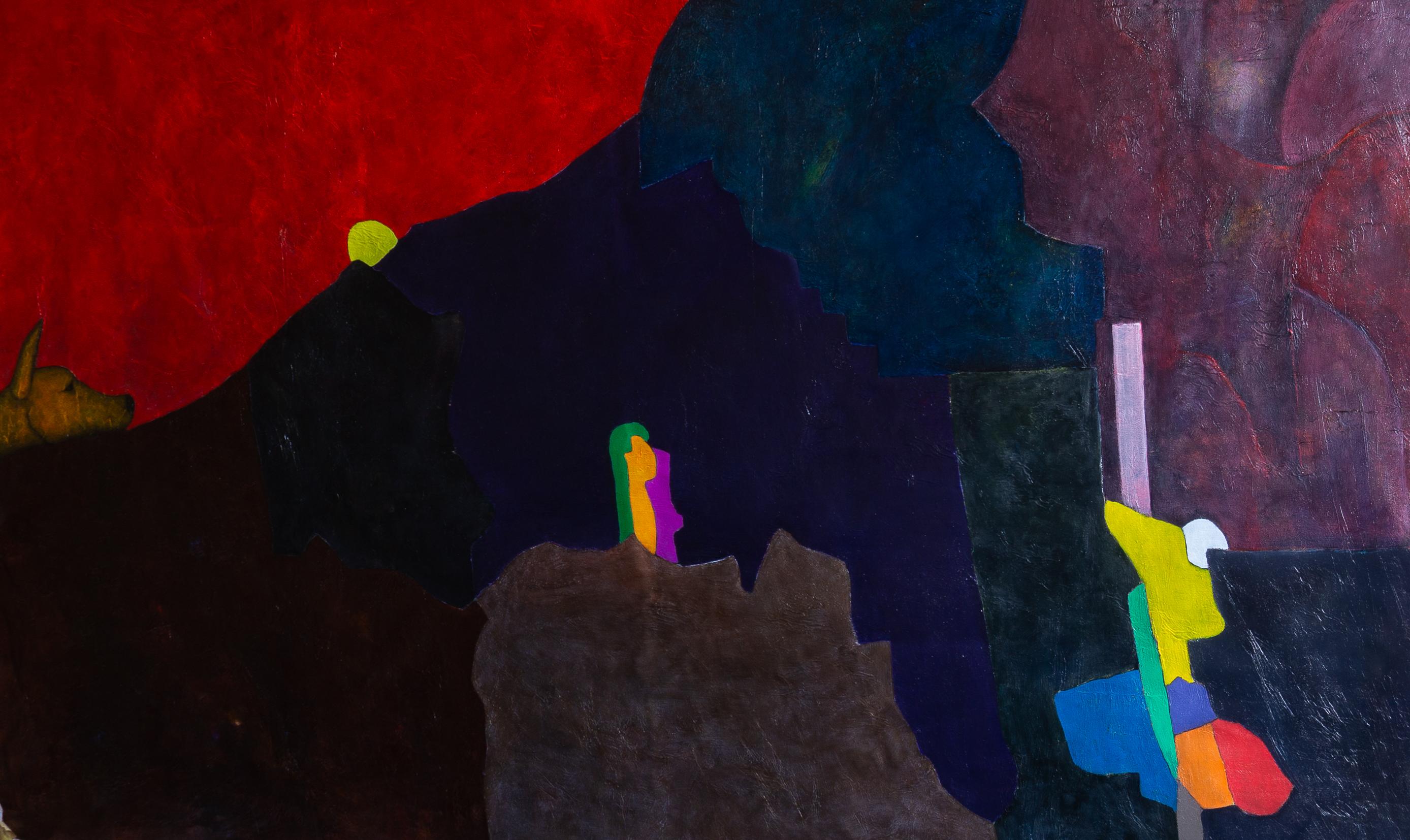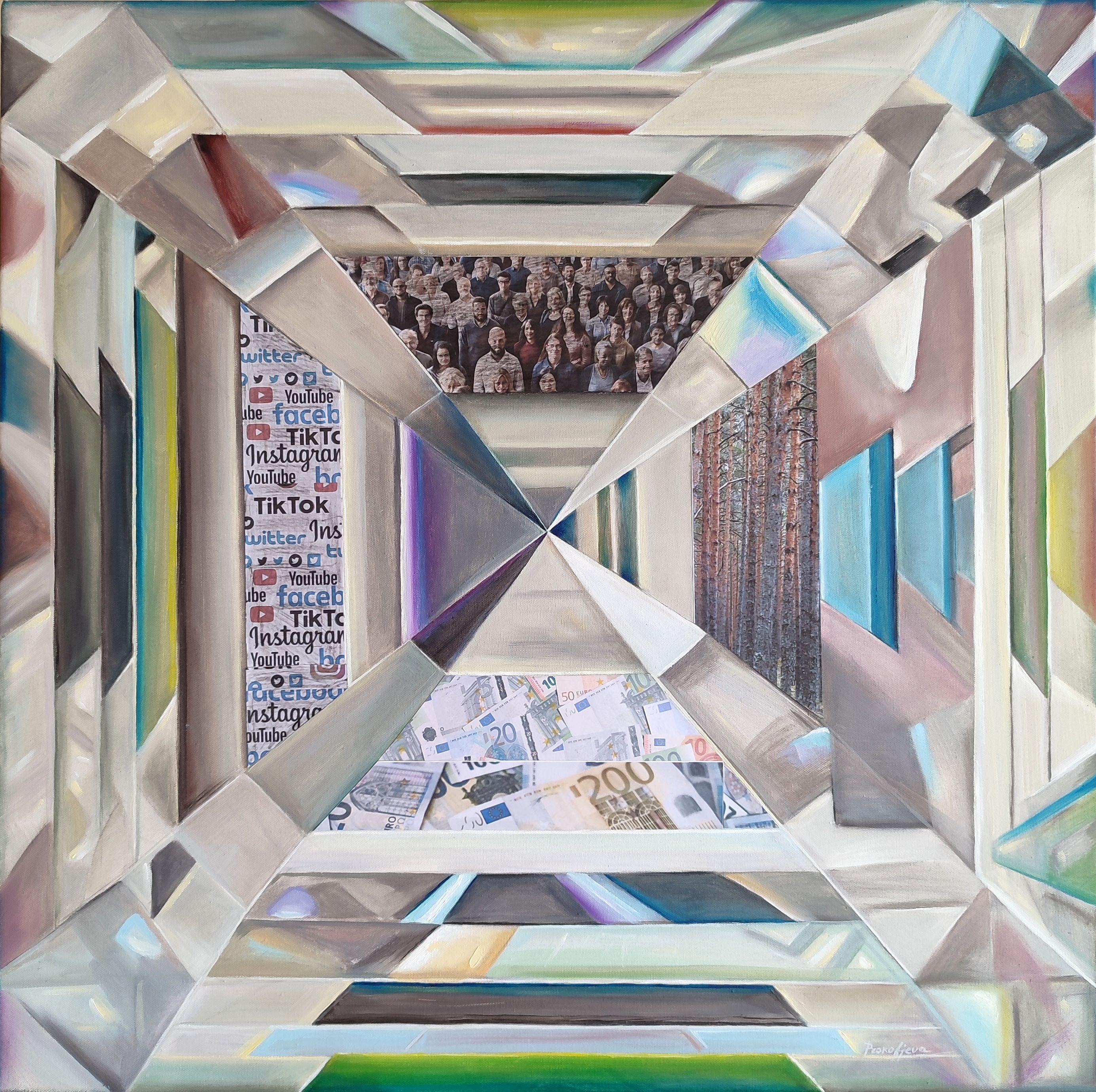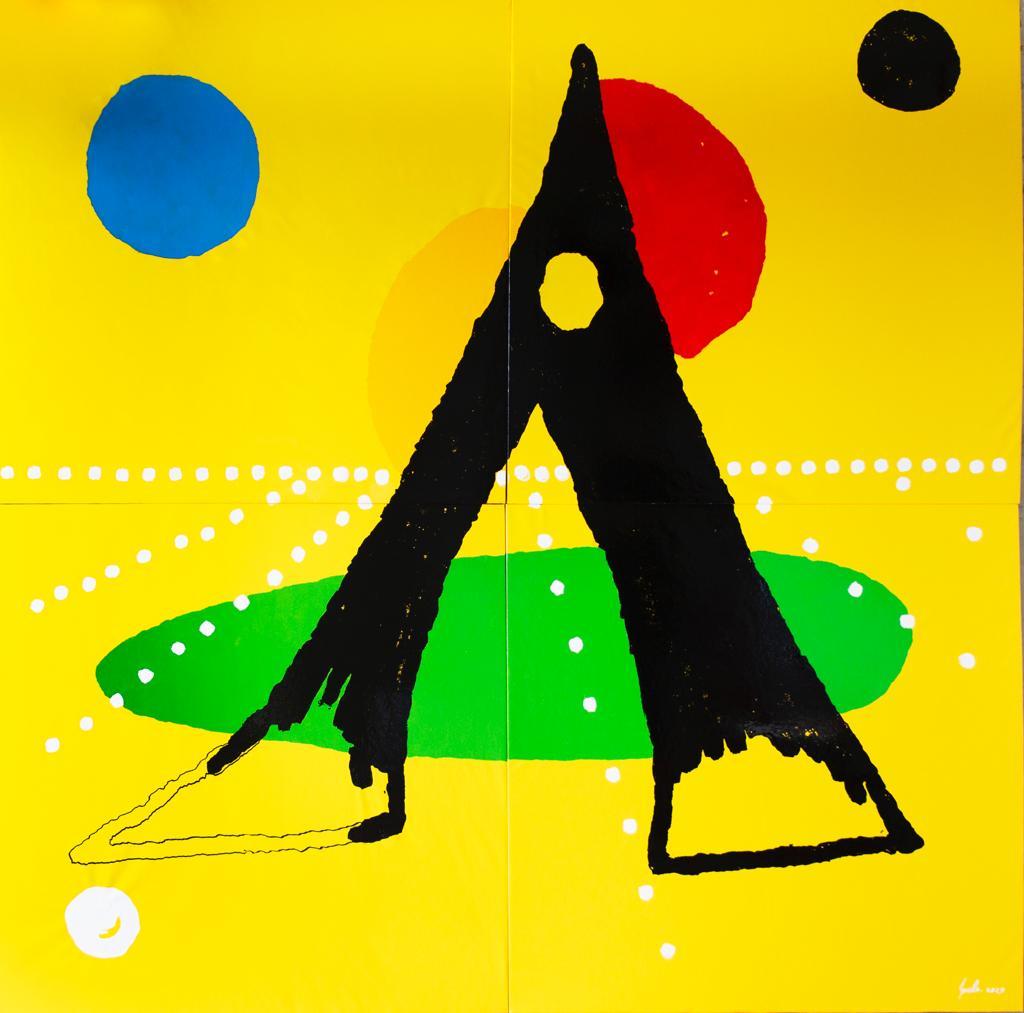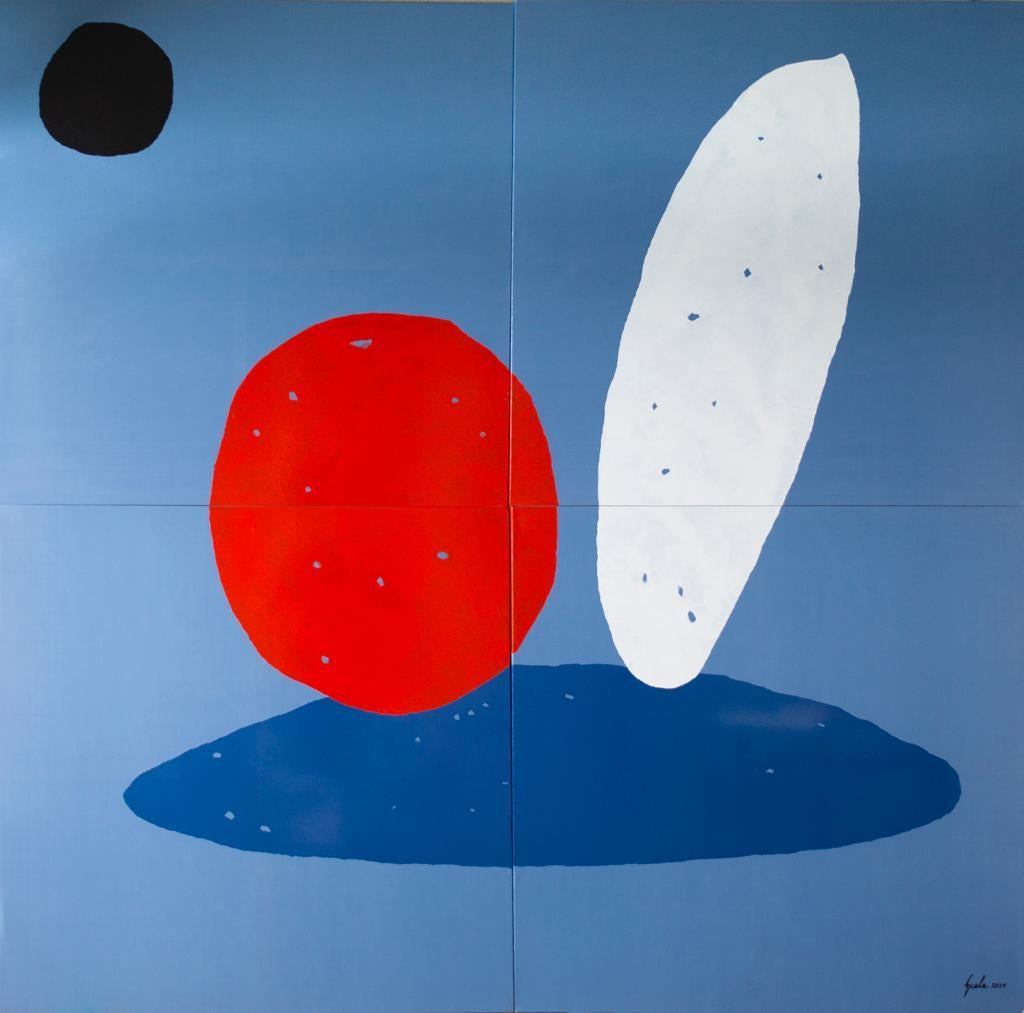Items Similar to Dark Structure, Abstract Surrealist Original Oil Painting, Signed
Want more images or videos?
Request additional images or videos from the seller
Herve CarrierDark Structure, Abstract Surrealist Original Oil Painting, SignedC.1950s
C.1950s
About the Item
Dark Structure, Abstract Surrealist Original Oil Painting, Signed
By French artist Herve Carrier, Mid 20th Century
Signed by the artist on the lower left hand corner and verso
Oil painting on canvas, framed
Framed size: 24.5 x 30.5 inches
Fine quality original abstract painting by the well listed French painter, Herve Carrier (1932-2000). The work is signed on the front as well as being studio stamped.
We have two paintings by this artist, both painted using a similar colour palette. Please enquire if you would like to see the other painting.
Hervé Carrier was born October 13, 1932 in Martigues (Bouches-du-Rhône).
He interrupts his studies at age 15 and paints his first painting. Apprentice to Merlin-Gerin, unhappy with his professional occupations, he cultivates a frantic absenteeism that allows him to discover the museum. His first art book is a Dufy monograph with a view of the old port of Marseille dated 1925. He then discovered modern painting with the fascicles published by Hazan in the early 1950s.
His first exhibition took place in Grenoble in February 1957, his work is then in the form of non-figurative varnished gouaches freely inspired by Fernand Léger.
In 1963, he accepted a job as a caretaker at the Museum of Painting in Grenoble, after 1970 the management of the reserves became his main activity at the museum.
In 1961, he made sculptures made of poor materials, often fragments of objects, sometimes articulated. He especially seeks in these montages a possibility of a playful approach of the sculpture which he tries to reconcile with his interest for the primitive arts.
As a result of the ideological effervescence of the moment, he stopped in 1968 any individual production for a group activity with Dody and Unal. They participate in the sixth Biennial of Paris, the exhibition Impact 2 at the Ceret Museum in 1972 just before the dissolution of the group.
The following year, he began a series of paintings composed of fragments of works of masters of modern art approximately reproduced and arbitrarily collected, which allow him to reconcile appropriation and misappropriation into a caustic tribute to the influence of the masters.
In 1981 he returned to sculpture long neglected because of a lack of space. This space is in the cellars of the museum where he works only part-time he finds it. And this time it is with the scrap dealers that he looks for his material.
"My sculptures are static, fixed of course, but the pieces are twisted, rounded, follow a rhythm, move and turn. It's an expression of freedom, the unpredictable. "
From 1983 to 1992 his pictorial works are humorous allusions to traditional iconography; Biblical scenes, still lifes, landscapes, are the main themes of compositions of a very effective incongruity.
"I start from a character, an attitude or a silhouette seen in an old painting. The quote is no longer really one. It's a kind of stimulation to paint. "
In 1993, finally retired, he moved to Veynes (Hautes-Alpes).
His new studio allows him to continue to practice sculpture, painting and drawing in the best conditions.
As far as painting is concerned, he returns to the abstraction that he experiences in all its forms.
___________________________________
MAIN PERSONAL EXHIBITIONS:
1957: Gallery Guilmin, Grenoble.
1974: Museum of Paintings and Sculptures of Grenoble.
1976: Gallery "The Head of Art", Grenoble.
1980 and 1983: CRAC, Grenoble.
1984: Gallery-Museum Geo-Charles, Echirolles (38).
1985: ACMAD, City Hall of Grenoble.
1987: Auditorium - Contemporary Art, Lyon.
And many group exhibitions.
Condition report:
The painting is in sound and very good condition.
- Creator:Herve Carrier (1932)
- Creation Year:C.1950s
- Dimensions:Height: 24.5 in (62.23 cm)Width: 30.5 in (77.47 cm)Depth: 1 in (2.54 cm)
- Medium:
- Movement & Style:
- Period:
- Condition:
- Gallery Location:Cirencester, GB
- Reference Number:1stDibs: LU50933663311

About the Seller
5.0
Platinum Seller
These expertly vetted sellers are 1stDibs' most experienced sellers and are rated highest by our customers.
Established in 1989
1stDibs seller since 2016
3,510 sales on 1stDibs
Typical response time: 2 hours
- ShippingRetrieving quote...Ships From: Cirencester, United Kingdom
- Return PolicyA return for this item may be initiated within 3 days of delivery.
More From This SellerView All
- Dark Modern Abstract, French Artist, Original Oil PaintingBy Franck DuminilLocated in Cirencester, GloucestershireDark Modern Abstract, French Artist, Original Oil Painting By French artist Franck Duminil (1933-2014) Signed by the artist verso Oil painting on canvas, unframed Canvas size: 19 x 1...Category
Mid-20th Century Abstract Abstract Paintings
MaterialsOil
- Abstract Oil Painting, Green, Blue and Gold ColourLocated in Cirencester, GloucestershireAbstract Oil Painting, Green, Blue and Gold Colour By French artist Roland Gautier, 20th Century Signed by the artist on the back of the painting Oil painting on board, framed Framed...Category
Late 20th Century Abstract Abstract Paintings
MaterialsOil
- Mid-20th Century Cubism Abstract Oil Painting, Multi Coloured, British ArtistLocated in Cirencester, GloucestershireCubism Abstract Oil Painting, Multi Coloured, British Artist British School, 20th century Oil painting on board, unframed Board size: 16 x 24 inche...Category
Mid-20th Century Abstract Abstract Paintings
MaterialsOil
- Large Abstract Oil Painting, Contemporary British ArtistLocated in Cirencester, GloucestershireLarge Abstract Oil Painting, Mythical Style, Signed. British School, indistinctly signed. Oil painting on canvas, unframed Signed on the bottom right hand corner, and also on the bac...Category
21st Century and Contemporary Abstract Abstract Paintings
MaterialsOil
- Triptych Sea Blue Oil PaintingsLocated in Cirencester, GloucestershireTriptych Sea Blue Oil Paintings By British artist 'KD', 20th Century Signed by the artist on the left hand corner of the first of three triptychs Oil painting on canvas, unframed Canvas size (individual sizes) 16x16 inches Wonderful opportunity to buy a triptych (a set of three paintings...Category
20th Century Abstract Abstract Paintings
MaterialsOil
- "Au Sommet du Mont-Blanc" Large French AbstractBy Anna ChimarasLocated in Cirencester, Gloucestershire"Au Sommet du Mont-Blanc" Large French Abstract By French artist, Anna Chimaras, 21st Century Signed by the artist on the lower left hand corner, and titled/si...Category
21st Century and Contemporary Abstract Abstract Paintings
MaterialsOil
You May Also Like
- Subconscious N0507.16Located in New York, NYA painting on wood panel, 96x72". Known for his erratic and expressive abstract works, Daniel Diaz-Tai uses various mixed media including sumi ink and...Category
2010s Abstract Abstract Paintings
MaterialsWood Panel, Ink, Sumi Ink, Oil
- Contemporary abstract oil painting in earth and ocher "A hero dog"Located in Bogotá, BogotáTo the memory of a hero dog Abstract painting 35" x 64" inches. Mixed technique. Oil on canvas made with professional Winsor & Newton colors protected with gloss varnish and UV prote...Category
2010s Abstract Abstract Paintings
MaterialsOil, Cotton Canvas
- Everyone has their own treasure. 2023 oil, collage, canvas, 70x70 cmLocated in Riga, LVEveryone has their own treasure. 2023 oil, collage, canvas, 70x70 cm In this artwork, author highlight 4 values that have the most power nowadays. Nature, people, money, social med...Category
2010s Abstract Abstract Paintings
MaterialsCanvas, Oil
- "Untitled 1" Painting 102" x 102" inch by GUELA TSOULADZELocated in Culver City, CA"Untitled 1" Painting 102" x 102" inch by GUELA TSOULADZE Oil painting on oilcloth canvases. ABOUT THE ARTIST: Nomad from birth, Guela Tsouladzé was born on November 8, 1959 in Tbilisi, Georgia, from a French mother and a Georgian father. His father was one of the first Georgian psychanalyst; but working with the conscient and subconscient of the homo sovieticus was a disputed occupation, criticized by the soviet ideology. Therefore, it required a significant dose of audacity; it’s in this context of insubordination and freedom, that Guela tirelessly repeats that he will be an artist, without ever having painted anything. The father thus commissioned his first work: a black dot on the ceiling of his office, which his patients would fix during the sessions. The gateway to hypnosis, and the artist’s future signature. Perhaps Guela's innate sense of daring and escapism comes from there; these two themes are till today reflected in his works. Guela grows up in a surreal artistic universe, between France and Georgia, inspired in particular by Pirosmani, the brothers Zdanevitch and Salvador Dali, whom he met shortly before his death in 1981 at Portiligat Cadaques, and surrounded by the filmmaker Paradjanov, a friend of the Tsouladze family. He begins his studies at the Fine Arts on Tbilisi in 1977, but the ultimate horizon is Paris. He joins the Art Décoratifs from 1980 to 1983 and then the Beaux-Arts from 1983 to 1985. He becomes the assistant of Christian Boltanski, whom he follows from exhibition to exhibition. In France, the 80s are colorful years, wild like a Fauvist painting. Art comes out of museums and gives birth to the free figuration, an elusive movement, which was slowly taking shape in the lethargy of the Beaux-Arts. Pop culture, in its spontaneity and in its lack of self-control, takes over everything and breaks down all codes, groups and borders. Art is free from all constraints and analysis. Guela is there at the right time, in the right place, with the right people. The Holy Trinity, as he likes to repeat. These crazy years are an ecstatic playground for his artistic instincts. Guela paints on everything: papers, canvases or newspapers. His grand formats are at the scale of his silhouette; he leaves the Beaux-Art and joins the first squats in the nineteenth arrondissement of Paris, notably the Quai de Seine workshop, which he shares with Remy Blanchard and Vincent Scali. These are the years of Ben, of the Di Rosa brothers, of Robert Combas and François Boisrond. Art for everyone, and party for all. Guela follows his intuitions to Ibiza and Barcelona from 1987 to 1993, where he works at the Casa Caritad, which will later become the city's Museum of Modern Art. This colorful and collective delight contrasts with the dark anxieties of our time. Contrary to the widespread dystopia, it was then the utopia that reigned! New York is its epicenter, shaped by Basquiat and Keith Haring. Guela lives there from 1993 to 1998, including several years at the legendary Chelsea Hotel, of which he covers the walls and furniture with Georgian calligraphy. This is where his simplistic, black, and loving figures were born, later becoming his trademark and one of the symbols of Batumi. It was precisely at the end of the 90s that his desire to build bridges between his native country and France became deeper. The Soviet Union died in a burst of freedom, and the Georgians slowly come out of a fratricidal war, fueled by Russia. Georgia needs love, so Guela replaces the flag’s crosses with hearts, following the 2003 Rose Revolution. Since then, convinced that art is the answer to the stress that is still plaguing Georgia, Guela multiplies projects for exhibitions, partnerships, festivals and art centers. He brings several French artists to the Garikula Residency, including Jean Dupuy...Category
21st Century and Contemporary Abstract Abstract Paintings
MaterialsCanvas, Oil
- "Untitled 2" Painting 102" x 102" inch by GUELA TSOULADZELocated in Culver City, CA"Untitled 2" Painting 102" x 102" inch by GUELA TSOULADZE Oil painting on oilcloth canvases. ABOUT THE ARTIST: Nomad from birth, Guela Tsouladzé was born on November 8, 1959 in Tbilisi, Georgia, from a French mother and a Georgian father. His father was one of the first Georgian psychanalyst; but working with the conscient and subconscient of the homo sovieticus was a disputed occupation, criticized by the soviet ideology. Therefore, it required a significant dose of audacity; it’s in this context of insubordination and freedom, that Guela tirelessly repeats that he will be an artist, without ever having painted anything. The father thus commissioned his first work: a black dot on the ceiling of his office, which his patients would fix during the sessions. The gateway to hypnosis, and the artist’s future signature. Perhaps Guela's innate sense of daring and escapism comes from there; these two themes are till today reflected in his works. Guela grows up in a surreal artistic universe, between France and Georgia, inspired in particular by Pirosmani, the brothers Zdanevitch and Salvador Dali, whom he met shortly before his death in 1981 at Portiligat Cadaques, and surrounded by the filmmaker Paradjanov, a friend of the Tsouladze family. He begins his studies at the Fine Arts on Tbilisi in 1977, but the ultimate horizon is Paris. He joins the Art Décoratifs from 1980 to 1983 and then the Beaux-Arts from 1983 to 1985. He becomes the assistant of Christian Boltanski, whom he follows from exhibition to exhibition. In France, the 80s are colorful years, wild like a Fauvist painting. Art comes out of museums and gives birth to the free figuration, an elusive movement, which was slowly taking shape in the lethargy of the Beaux-Arts. Pop culture, in its spontaneity and in its lack of self-control, takes over everything and breaks down all codes, groups and borders. Art is free from all constraints and analysis. Guela is there at the right time, in the right place, with the right people. The Holy Trinity, as he likes to repeat. These crazy years are an ecstatic playground for his artistic instincts. Guela paints on everything: papers, canvases or newspapers. His grand formats are at the scale of his silhouette; he leaves the Beaux-Art and joins the first squats in the nineteenth arrondissement of Paris, notably the Quai de Seine workshop, which he shares with Remy Blanchard and Vincent Scali. These are the years of Ben, of the Di Rosa brothers, of Robert Combas and François Boisrond. Art for everyone, and party for all. Guela follows his intuitions to Ibiza and Barcelona from 1987 to 1993, where he works at the Casa Caritad, which will later become the city's Museum of Modern Art. This colorful and collective delight contrasts with the dark anxieties of our time. Contrary to the widespread dystopia, it was then the utopia that reigned! New York is its epicenter, shaped by Basquiat and Keith Haring. Guela lives there from 1993 to 1998, including several years at the legendary Chelsea Hotel, of which he covers the walls and furniture with Georgian calligraphy. This is where his simplistic, black, and loving figures were born, later becoming his trademark and one of the symbols of Batumi. It was precisely at the end of the 90s that his desire to build bridges between his native country and France became deeper. The Soviet Union died in a burst of freedom, and the Georgians slowly come out of a fratricidal war, fueled by Russia. Georgia needs love, so Guela replaces the flag’s crosses with hearts, following the 2003 Rose Revolution. Since then, convinced that art is the answer to the stress that is still plaguing Georgia, Guela multiplies projects for exhibitions, partnerships, festivals and art centers. He brings several French artists to the Garikula Residency, including Jean Dupuy...Category
21st Century and Contemporary Abstract Abstract Paintings
MaterialsCanvas, Oil
- Mushroom rain mantra. 2002, oil on canvas, 95, 5x90, 5 cmBy Igor LeontievLocated in Riga, LVMushroom rain mantra. 2002, oil on canvas, 95,5x90,5 cm Abstract composition in earth colors Igor Leontiev (1957) - one of the leading independent painters in Latvia Born in Riga, ...Category
Early 2000s Abstract Abstract Paintings
MaterialsCanvas, Oil
Recently Viewed
View AllMore Ways To Browse
Dark Vintage Art
Surrealist Signed
Round Signed Art
Original Abstract Mid Century Modern
Vintage 1950s Signed Oil Painting
Abstract Quote
Mid Modern Dark Art
Sign Fragment
Old Vintage Oil Painting Signed Paintings
The Vintage Cellar
Fragment Oil Painting
Oil Painting Fragment
Abstract Surrealist Oil Painting
1950s Abstract Oil Paintings
Round Modern Painting
Round Abstract Painting
Round Oil Painting
Abstract Oil Painting Head




